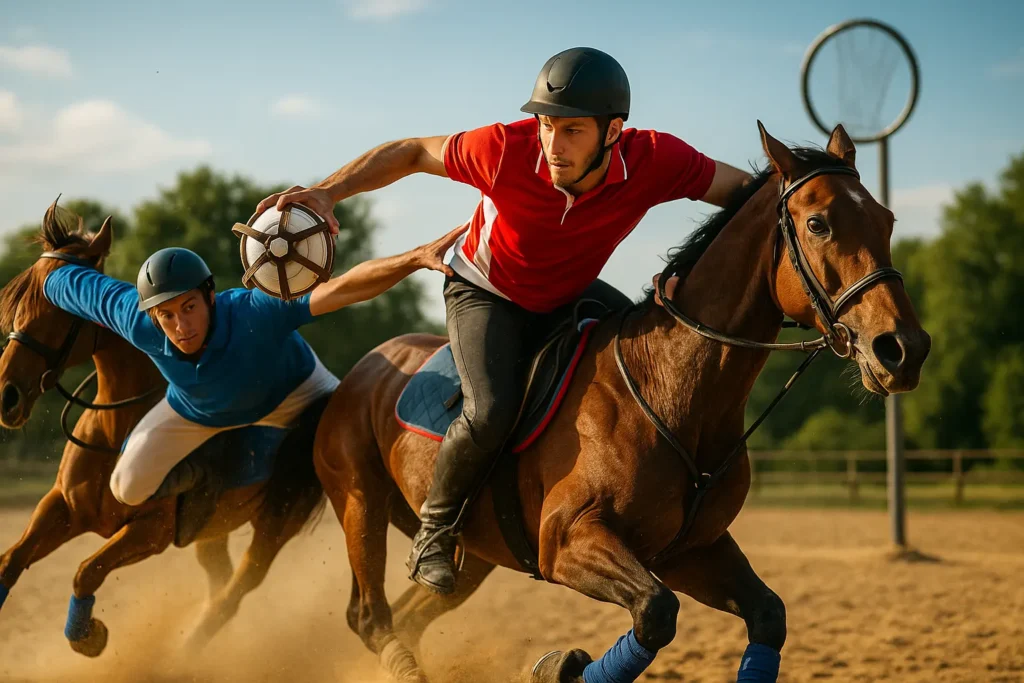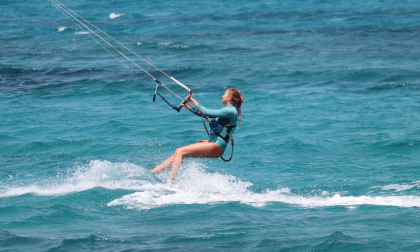Have you ever wondered why horseball attracts so many enthusiasts despite its mysterious nature? This equestrian sport, blending rugby, basketball and horsemanship, traces its roots back to 17th-century Argentina under the name pato a violent game once played with a real duck.
Now strictly codified, it requires three passes between three players before scoring, a maximum 10-second possession, and complete harmony between rider and horse.
Discover its history, its acrobatic “pick-up” technique, and why this fast-paced sport safeguarded by strict refereeing fascinates audiences seeking unique thrills.
What is horseball, this spectacular equestrian sport?
Imagine a mix between rugby, basketball and equestrian skill, played at full speed on a 65-metre field. Horseball is a team sport where rider-horse cooperation meets tactical strategy to score goals through a ring suspended 3.5 metres above the ground. A blend of adrenaline and precision that turns every match into a gripping show.
Inspired by the Argentine pato of the 17th century a dangerous game involving a live goose modern horseball was born in France in the 1970s, thanks to Jean-Paul Dupont. Today, it balances safety and competition with strict rules protecting both riders and horses.
Teams of four riders compete on a rectangular field, passing a 65-cm ball between three players before scoring, under the watchful eyes of mounted referees and veterinarians.
This sport demands speed, precise passing and refined riding skills. Why is it so special? Because it stands as one of the most original team sports, merging equestrian tradition with competitive spirit. With international tournaments organised by the International Horse-Ball Federation (FIHB) since 1999, it draws more and more enthusiasts every year eager to experience its unique rush of adrenaline.
The origins of horseball: from the Argentine pato to its French codification
The Argentine ancestor: the pato
Imagine an equestrian sport where, in 1610, players fought over a live duck trapped in a basket. That was the pato, the ancestor of horseball, born in Argentina.
This brutal game often led to falls, trampling, and even knife duels between gauchos. In 1796, a priest even forbade Christian burial for anyone who died during a pato match.
Banned several times during the 19th century, pato resurfaced in the 1930s when Argentine landowner Alberto del Castillo Posse modernised the rules, drawing inspiration from polo. The duck was replaced by a 1.2-kg leather ball with six handles. This transformation saved the sport, which became Argentina’s national sport in 1953, although it never rivalled football in popularity.
The birth of modern horseball in France
In France, horseball emerged in the 1970s thanks to Jean-Paul Dupont, a riding instructor and rugby enthusiast. Inspired by pato and the Afghan buzkashi, he envisioned a pedagogical sport to strengthen the bond between horse and rider. The ball, equipped with six handles, was designed to be picked up at full speed, without endangering the horses.
The first French championship took place in 1979. In 1991, horseball crossed the Channel thanks to Jim Copeland, marking its international expansion. Today, the International Horse-Ball Federation (FIHB) oversees competitions, while France dominates the world stage with over 4,000 players. From Argentina to Europe, horseball represents a spectacular fusion of tradition and innovation.
How a match unfolds: rules and game objectives
The field, teams and match duration
Horseball is played on a rectangular sand field, 65 metres long and 25 metres wide, ensuring safety for both riders and horses. Each team consists of six players, four of whom are on the field at once. Two substitutes may enter the game at any time.
Goals are circular rings, one metre in diameter, placed at each end of the field and suspended 3.5 metres above the ground. A match lasts 20 minutes, divided into two 10-minute halves with a 3-minute break. Each team is allowed one 30-second timeout per half.
The fundamental rules to score
To score a valid goal, the attacking team must make at least three passes between three different players before shooting. This rule promotes fast-paced and strategic play.
A player may hold the ball for no longer than 10 seconds, encouraging constant movement and teamwork. The ball, a size 4 football with six leather handles, is picked up from the ground while riding.
Key game elements:
- Objective: Score through the opposing team’s ring
- Condition to shoot: Minimum of 3 passes between 3 different players
- Possession: A player may hold the ball for up to 10 seconds
- Team composition: 4 players on the field per team
- Match duration: 2 halves of 10 minutes each
Originating in 17th-century Argentina under the name Pato, with dangerous rules, horseball evolved throughout the 20th century. In France, Jean-Paul Dupont modernised the sport about 20 years ago, introducing safety and fair-play standards.
Today, the International Horse-Ball Federation (FIHB) governs competitions that attract teams from several countries. This sport combines precision, coordination and speed, highlighting respect for both horses and opponents.
The technical skills of horseball
The pick-up: an acrobatic move
The pick-up is a key technique in horseball. A player must grab the ball from the ground without dismounting, at any speed except when stationary. Riders use a pick-up strap passing beneath the horse’s belly to secure the stirrups, allowing them to lean safely. This action demands perfect synchronisation between horse and rider.
Rules protect the player performing a pick-up: no opponent may obstruct their movement. Failure to comply results in a P3 penalty. Priority to pick up the ball depends on proximity or which team last touched it. The player must avoid slowing down or changing direction abruptly during the manoeuvre.
Attack, defence and authorised contact
In defence, ball stealing is done one-handed. The “dispossession” move, where two players contest the ball, must also be performed with one hand and without grabbing the opponent’s harness or horse. The action must go from bottom to top, without endangering others. Poorly executed steals result in penalties.
Horse contact occurs shoulder to shoulder, within a 45-degree angle limit. Defenders must stay aligned with the direction of play to prevent collisions. Offensive fouls (charging) and defensive fouls (improper marking) lead to penalties ranging from P3 to P1, ensuring the safety of riders and horses.
Controlled contact is key to avoiding injury.
Essential equipment and the ideal horse
What kind of horse is suited for horseball?
Horseball requires a horse with unique qualities: agility, responsiveness and the ability to adapt to fast-changing movements. Speed and strength are crucial to keep up with the intense pace of passes and sprints.
Temperament is a deciding factor: the horse must remain calm yet alert, attentive to its rider, and comfortable with contact from other players and the ball.
A social, well-balanced horse helps reduce risks linked to fear or aggression.
Training and education are essential. The horse must transition smoothly between galloping and stopping, without stress, and accept the ball as a familiar object.
Progressive desensitisation to the ball in a secure environment is recommended.
Rider, horse and game equipment
| Category | Equipment |
| For the game | Size 4 ball (600-700g) with six leather handles |
| For the rider | Helmet (mandatory), knee pads, team uniform, often spurs |
| For the horse | Leg protection (boots or bell boots), suitable saddle, pick-up strap linking stirrups |
The rider’s equipment includes an EN1384-certified helmet, knee pads for shock absorption, and spurs (max length 3 cm). Gloves improve grip, while a numbered jersey makes players easily identifiable.
For horses, leg boots or bell boots protect the limbs. A mixed saddle provides comfort and freedom of movement. The pick-up strap (leather reinforced with nylon) secures the stirrups during leaning movements, reducing the risk of falls. The horseball itself is specifically designed for optimal grip, thanks to its leather handles. Its size (65 cm, 600-700g) allows for quick passes while remaining manageable on horseback.
Safety, refereeing and fouls: a highly regulated sport
Fouls and penalties
As a team sport on horseback, horseball imposes strict regulations to protect both competitors and animals. Fouls are divided into three categories:
- Offensive fouls: e.g. a player charging a defender or waving the ball aggressively (P1 to P3 depending on severity).
- Defensive fouls: a defender backing up deliberately to block an attacker or elbowing (P2 to P1, often punished with a yellow card).
- Technical fouls: unsporting behaviour such as insulting a referee or wearing forbidden jewellery (P3 to P1).
Gradual sanctions include:
- P3: ball returned without stopping the clock
- P2: direct shot from 10 metres or throw-in
- P1: 5-metre shot, horse stopped
Two yellow cards result in automatic expulsion. Understanding these penalties highlights the importance of insurance in such an intense sport.
Refereeing and veterinary checks
Matches in the Minime and higher categories are overseen by three referees: one on a raised chair (penalty management) and two on foot (zone control). Only the captain, wearing an armband, may speak to them.
Referees use a codified set of hand signals (e.g. raised hand for P1, closed fist for a card) and communicate via walkie-talkies to coordinate decisions.
A veterinarian checks the horses’ condition before the match and at half-time, ensuring proper equipment (harnesses, spurs) and soundness (no lameness).
Any sign of fatigue or injury results in immediate withdrawal. This supervision, enforced by the French Equestrian Federation, ensures equine welfare remains a top priority.
Horseball on the competitive scene
Categories for all ages
Horseball appeals to a wide audience thanks to its numerous age divisions.
Youth categories:
- Club A Moustiques: 8 years and under
- Club A Poussins: 9–10 years
- Club Pony Benjamins: 11–12 years
- Club Pony Minimes: 13–14 years
- Club Pony Cadets: 15–16 years
Adult categories:
- Club Espoirs: 15–21 years
- Club Espoirs Féminines: 15–21 years (women’s)
- Club Pro Elite: professional level
- Club Pro Féminine: high-level women’s competition
Major competitions and the international federation
Horseball has a rich calendar of major events.
The World Championship, held every four years since 2008, features the best nations, with Spain and France historically dominating. The European Championship, launched in 1992, gathers the top continental teams, where France boasts the most impressive record.
The International Horse-Ball Federation (FIHB), founded in 1999, unites 18 nations worldwide, defining the game’s official rules and organising international competitions. With the Champions League, regional European leagues and Under-16 and Under-21 championships, horseball offers a complete competitive pathway.
Horseball, blending rugby, basketball and equestrian skill, bridges Argentine tradition and French modernity. Requiring perfect rider-horse harmony, tactical thinking and technical mastery, its strict rules, adapted equipment and international events make it a dynamic, safe and spectacular sport a must-see for its unique mix of speed, precision and showmanship.



